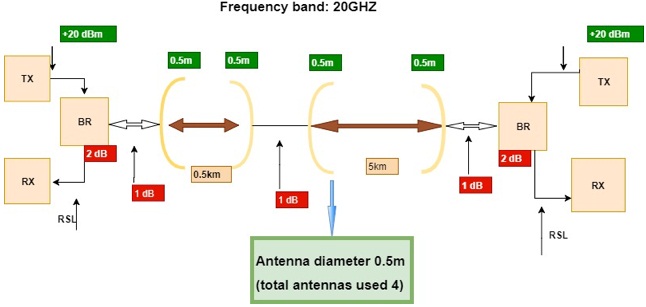Reference no: EM132381853
Assessment - Task and Research Project
Task 1: Microwave Link Budget Design
Microwave communication is commonly used as a backbone transmission system in wireless communication networks. As a wireless network engineer, you are often required to perform link budget calculations for such Microwave links. One such link is shown below in Figure 1 which operates in the 20 GHz radio frequency band. This link provides 4 Mbps transmission capacity at both transmitter and receiver sides. Furthermore, the system deploys a passive repeater. Following table shows numerical values for this transmission system.
|
Transmitter
|
|
RF Output Power - High Power Version:
|
+20 dBm
|
At Transmission port
|
|
Tx RF Branching loss
|
2 dB
|
From Transmitter to antenna
|
|
Receiver
|
|
|
|
Rx RF Branching loss
|
2 dB
|
From Antenna to Receiver
|
|
Antenna Parameters
|
|
|
|
Antenna diameter= 0.5 m
|
|
|

Figure 1: Microwave Link Configuration
1. Calculate the nominal Receive Signal Level (RSL) at the input of the receiver in dBm assuming free space conditions.
2. Briefly discuss the purpose of the passive repeater in this system?
Task 2: Innovative Research Project
A local engineering group ask you to present your finding of the most recent advanced wireless technologies such as 5G and millimeter Wave (mmWave) communication for future generation wireless communication. Research these technologies in details and pay specific attention to (one of them) and discuss how they are used, their application in real life, their strengths and weakness and security issues. You need to provide at least three recent reference articles to your technology of choice. Also provide an opinion regarding which antenna types will become the dominant players in the future such as you may consider physical antenna structures or antenna related signal processing such as multiple-input multiple-output (MIMO) techniques etc.
Deliverable: You need to provide a report on your selected wireless communication technology. The report should include Abstract, Introduction, Body of the report that may include sections such as real life applications, advantages and challenges, security issues etc (body of the report vary for each student), conclusion and references. Your report should not be more than four A4 pages long including everything, i.e. from first page to the last page of references. In general, four A4 pages with the font size of 11 may have 2000 words (maximum). The report has 6% of the total task 2 weight-age.
You are also required to give a short upto 10 minutes oral presentation during the online meeting or in the class. Your lecturer will schedule time for your oral presentation. Your presentation should have maximum 10-12 slides. The presentation has 4% of the total task 2 weight-age.
Rationale
This assessment task will assess the following learning outcome/s:
• be able to investigate and evaluate various wireless networking protocols and standards.
• be able to compare and contrast different wireless networks in terms of size, speed, limitations and applications.
• be able to investigate and evaluate emerging wireless networking technologies.
• be able to investigate theoretical and practical issues relating to wireless technology and communicate the results to specialist and non-specialist audiences.
• be able to identify the challenges and security issues posed by wireless networks.